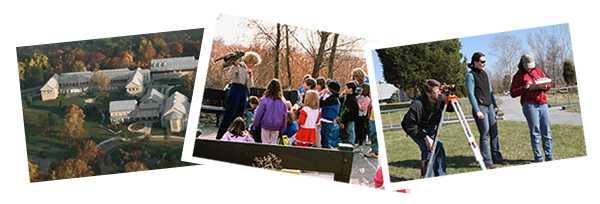Welcome to the FNCTC
Kid's Page
Activity for May-August:
By the end of this scavenger hunt, students will be able to:
- Identify and name the colors of the rainbow using the acronym ROYGBIV (Red, Orange, Yellow, Green, Blue, Indigo, Violet).
- Observe and describe natural elements in their environment that correspond to each color of the rainbow.
- Demonstrate basic understanding of how certain natural objects or phenomena exhibit specific colors (e.g., red berries, yellow flowers, blue sky).
- Engage in collaborative exploration and discussion with friends about their findings during the nature hunt.
- Express creativity through a follow-up activity such as creating a rainbow collage or artwork inspired by their outdoor discoveries.
These objectives are designed to encourage students to actively participate in the nature hunt, develop their observational skills, learn about colors in nature using the ROYGBIV acronym, and engage in creative expression based on their experiences.
Have fun in your nature hunt!
Activity One: Children’s story based on the Rainbow Scavenger Hunt
Once upon a sunny day in the land of Green Valley, a group of curious children gathered near a sparkling stream. They were excited because today was the day of the Nature Rainbow Scavenger Hunt!
Their teacher, Mrs. Willow, stood in front of them with a big smile. "Welcome, little explorers! Today, we are going on a special adventure to discover the colors of the rainbow in nature."
The children cheered and listened attentively as Mrs. Willow explained the rules. "We will be looking for items in nature that match the colors of the rainbow: Red, Orange, Yellow, Green, Blue, Indigo, and Violet. Remember the ROYGBIV acronym!"
With their baskets in hand, the children set off along the winding path, eager to find treasures of every hue (shades of a color).
First, they spotted a bright Red ladybug resting on a leaf. "Red for the first color of the rainbow!" exclaimed Emily, carefully adding the tiny insect to her collection.
Next, they discovered juicy Orange carrots growing in a nearby garden. "Orange, just like the setting sun!" shouted Alex, holding up the carrots proudly.
As they ventured deeper into the woods, they found Yellow buttercups swaying in the breeze. "Yellow like sunshine!" sang Sarah, gathering the golden blooms.
Then, they came upon a lush Green meadow dotted with clover and moss. "Green, the color of the forest!" grinned Lucas, admiring the emerald shades around them.
Their journey led them to a tranquil Blue pond reflecting the sky above. "Blue, like the water and sky!" exclaimed Mia, pointing at the shimmering surface.
As the day progressed, they searched high and low for Indigo and Violet treasures. Finally, they stumbled upon a patch of deep Indigo blueberries.
And delicate Violet wildflowers hiding among the grass.
With their baskets full and hearts happy, the children returned to Mrs. Willow. They gathered in a circle and shared their colorful finds, learning about the natural world and the rainbow's magic.
Back in the classroom, they used their treasures to create a magnificent rainbow collage. Each child placed their items in order, creating a masterpiece of nature's colors.
Mrs. Willow smiled at their artwork and said, "Today, you all became rainbow wizards, finding magic in every color of our world. Remember to keep exploring and discovering the wonders around us!"
And so, the children of Green Valley learned valuable lessons about colors, nature, and teamwork, all while having a delightful adventure on their Nature Rainbow Scavenger Hunt.
Activity Two: Vocabulary Words
Scavenger Hunt: A game or activity where participants search for specific items or clues in a designated area.
Acronym: A word formed from the initial letters or parts of a series of words to create a shorter way to refer to that series (e.g., ROYGBIV for Red, Orange, Yellow, Green, Blue, Indigo, Violet).
Treasures: Valuable or special items that are discovered or cherished.
Lush: Describes an area that is abundant, green, and full of vegetation.
Reflecting: To throw back light, heat, or sound from a surface; in the story, the pond was reflecting the sky.
Magic: Enchantment or a mysterious quality that makes something special or extraordinary.
Masterpiece: A work of outstanding artistry, skill, or workmanship.
Wizard: A person who is skilled or knowledgeable in a particular field; in the story, the children became "rainbow wizards" by learning about colors in nature.
Valuable: Something that is worth a lot of money or is considered very important or useful.
Teamwork: Cooperative work done by a group of people to achieve a common goal or task.
Activity Three: Questions Based on the Story
What special event were the children excited about in the story?
What acronym did Mrs. Willow use to help the children remember the colors of the rainbow?
Can you name one item the children found that matched the color Red during their scavenger hunt?
Where did the children find Orange items during their adventure?
Which color in the rainbow did the children associate with the lush meadow they discovered?
Describe one thing the children found that matched the color Blue during their nature hunt.
What two colors did the children find last during their scavenger hunt?
What did the children create with their nature treasures when they returned to the classroom?
How did Mrs. Willow encourage the children to continue exploring and discovering after their adventure?
What valuable lessons did the children learn during their Nature Rainbow Scavenger Hunt?
Answers to the Questions Above
The children were excited about the Nature Rainbow Scavenger Hunt in the story.
Mrs. Willow used the acronym ROYGBIV (Red, Orange, Yellow, Green, Blue, Indigo, Violet) to help the children remember the colors of the rainbow.
One item the children found that matched the color Red was a ladybug resting on a leaf.
The children found Orange items in a nearby garden where juicy carrots were growing.
The children associated the color Green with the lush meadow they discovered.
One thing the children found that matched the color Blue was a tranquil pond reflecting the sky.
The two colors the children found last during their scavenger hunt were Indigo and Violet.
The children created a magnificent rainbow collage with their nature treasures when they returned to the classroom.
Mrs. Willow encouraged the children to continue exploring and discovering by reminding them to keep finding magic in every color of the world.
The children learned valuable lessons about colors, nature, teamwork, and the magic of exploration during their Nature Rainbow Scavenger Hunt.
We have borrowed liberally from www.thechaosandtheclutter.com for many of these program ideas. For more ideas and games, we hope you will visit their site.
Parents and teachers can download the PDF version of our activities here!
We hope you enjoyed these activities!
Submit a photo of you doing this month's activity and you may be featured on our page next month! Or, let us know if you have any suggestions for the next program theme.
If you had fun with our activities, check out Conservation Connect: an environmental education program for students and teachers.
Friends of NCTC Program Activity
c. 2021, Friends of the National Conservation Training Center














